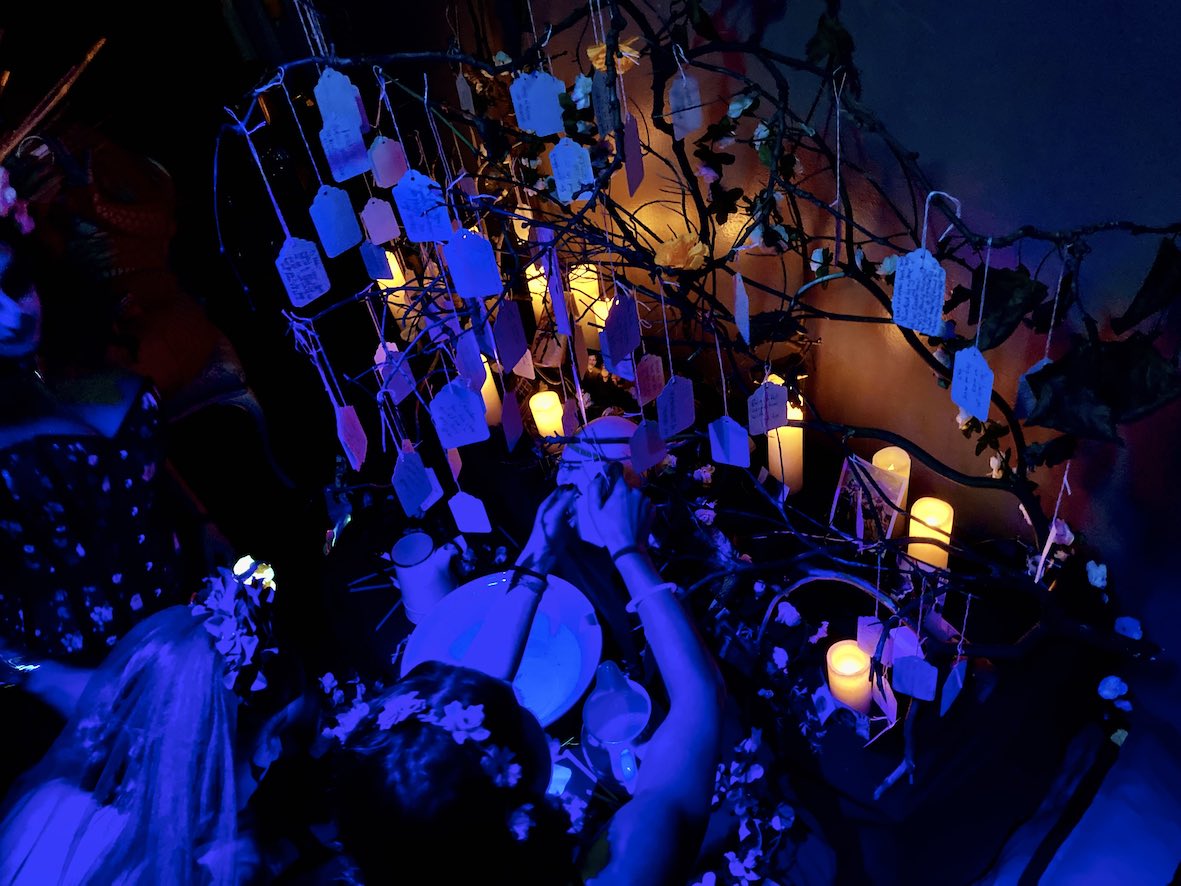05 Dec The Day of the Dead
The ‘Day of the Dead’ theme has struck an increasingly powerful chord in youth culture in the UK over the last few years. ‘El Dia de los Muertos’ as it is known in Spanish has evolved and spread from Mexican culture, blending indigenous and Christian traditions over the centuries. The film ‘Coco’ popularised the theme in 2017 for a generation of young people.
But it is more than a time for Halloween dressing up with tricks and treats. Many are hungry for a deeper connection with mortality, with ancestors, with acknowledging those who have gone before. People came to our pre-party workshop at Fox and Badge to mark their own private sorrows, and also collective themes.
Tony Pletts, Bilal Nasim and I are being invited to devise ‘Embracing Grief’ rituals for different settings. These take different forms to suit the situation, and number of people. Recently this has included a large community ritual at the Medicine Festival for around 120 people (with Sophy Banks), and a workshop designed for Fox and Badge for their Day of the Dead party for 40 or so participants. This took place in a night club at the beginning of a night of playful celebration.
When designing the format and content of an event, we have to consider what this particular group of people might feel comfortable with. In our Grief Tending groups there is often a wide diversity of social class, race, faith, age and GSRD (Gender, Sexuality and Relationship Diversity); and we aim to assist everyone to feel comfortable enough together in what is often very unfamiliar territory.
The basic shape of Grief Tending – the arc of experience, starts by bringing people together and recalling the support we have access to. Then we use trauma sensitive principles like ‘pendulation’ and ‘titration’ to move step by step towards feeling (or the absence of feeling). These are trauma tools originally described by Peter Levine. There is an invitation for some kind of expression, through different practices. Then we invite exercises to soothe the nervous system, followed by some simple integration processes. This basic pattern can look very different according to time available, number of people, location and setting.
The way we work has its roots in the indigenous practices of the Dagara People, blended with modern psychological understandings, and underpinned by neuroscience. You can see more in the short video ‘Where Does Grief Tending Come From?’ In bringing these strands together, we create an embodied way of working that adapts old ways for a modern, urban environment.
Some may suspect Grief Tending is ‘woo woo’; but bringing forms of grief ritual is both an antidote to a ‘death-phobic culture,’ and a radical way to begin to process the trauma residues from systems of harm (check out Healthy Human Culture). As Audre Lorde so aptly puts it, “The master’s tools will never dismantle the master’s house”. The power of this work to increase our capacity for feeling awkward is one of its strengths. As one recent participant recently described, “this is the work of sacred activism”.
Standing before an audience of creatively costumed grievers was an interesting experience. Behind masks and face paint were beautiful, vulnerable humans that I probably wouldn’t recognise in the street. Tony, Bilal and I are no strangers to the carnival world of dressing up and immersive theatre, so we welcomed this invitation. Wondering whether our Francis Weller’s ‘Gates of Grief’ mats would be swept away by the train of a ball gown was a problem I hadn’t previously given any thought to.
We invited these colourful creatures to move between support and grief via two shrines. One ‘Love Shrine’ to express gratitude and praise, to count our blessings, and the other ‘Grief Shrine’, to mark suffering and loss. After the workshop, others came to add their own mementoes of remembrance to the growing number of griefs and gratitudes.
We were careful in the design of this event to tread gently. We felt it was important in this context to point towards but not to open up to deep exploration, where boundaries, communication and responses were more unpredictable than at one of our smaller gatherings. But the conversations and expressions that we encountered spoke of the need for both remembrance and play, and rituals to open us to the significance of both love and loss.
To discover Grief Tending events in person and online, or to invite us to create something for you email us.




No Comments